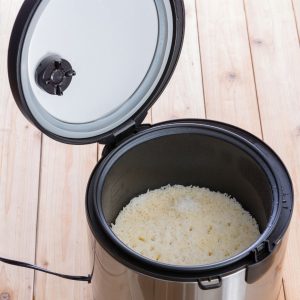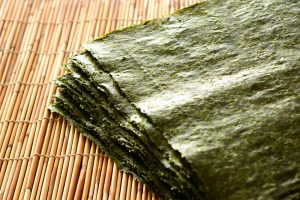
Culinary Quickies With Shoshana February 2022
Reader Question:
What type of rice should I use to make sushi rice and what is the best way to cook sushi rice?
Answer:
 You’re not alone in wondering this – making sushi rice is easy but it takes a little bit of knowledge and practice to get it just right. Believe it or not, the type of rice used to prepare sushi rice makes a huge difference and will have an effect on the outcome of your finished product. Japanese short grain rice is preferred but any other short grain rice will work. White rice is traditional, although short grain brown rice may also be used. Sushi rice can be prepared in a pot on the stove, in a rice steamer, instant pot, or in a traditional Japanese Donabe. The recipe and method below is based on a recipe from justonecookbook.com and is really the best and simplest for delicious sushi rice.
You’re not alone in wondering this – making sushi rice is easy but it takes a little bit of knowledge and practice to get it just right. Believe it or not, the type of rice used to prepare sushi rice makes a huge difference and will have an effect on the outcome of your finished product. Japanese short grain rice is preferred but any other short grain rice will work. White rice is traditional, although short grain brown rice may also be used. Sushi rice can be prepared in a pot on the stove, in a rice steamer, instant pot, or in a traditional Japanese Donabe. The recipe and method below is based on a recipe from justonecookbook.com and is really the best and simplest for delicious sushi rice.
Reader Question:
Do the seaweed and specialty products I use to make sushi need to be certified kosher?
Answer:
 The simple answer is yes. Seaweed products, rice wine vinegars, pickled ginger and many other packaged ingredients used in making sushi require an accepted hechsher. Before you begin to make sushi at home you should consult your rabbi or an expert on kashrut.
The simple answer is yes. Seaweed products, rice wine vinegars, pickled ginger and many other packaged ingredients used in making sushi require an accepted hechsher. Before you begin to make sushi at home you should consult your rabbi or an expert on kashrut.
Sushi Rice
Makes 5 to 6 servings – approximately 7-11 rolls
Ingredients:
3 rice cooker cups* Japanese short grain rice
2 ¼ cups (regular cups) cold water plus more for rinsing rice
1 piece Kombu (dried Kelp)** about 2” x 2”
⅓ cup (regular cups) bottled seasoned rice vinegar OR ⅓ cup homemade seasoned rice vinegar
Homemade Seasoned Rice Vinegar:
⅓ cup (regular cup) rice vinegar
3 tablespoons sugar
1 ½ teaspoons sea salt / kosher salt
Notes
* The measuring cups used for a rice cooker are not equal to a standard cup. A rice cooker measuring cup is equal to 150g or roughly 5.3oz.
** The hechsher for the Kombu can be found here.
Step-by-Step Instructions for making the Seasoned Rice Vinegar:
- Put all of the ingredients into a saucepan and heat on medium.
- Stir to combine.
- Continue stirring until sugar and salt have dissolved completely.
- Remove from heat.
(This recipe can be doubled, tripled etc. and stored for future use in a glass or non porous container in the refrigerator for months.)
Step-by-Step Instructions for preparing rice in a rice steamer: (If using a pot on the stove see notes)
1. Wash the rice by placing the measured rice into a bowl and covering with enough cold water to submerge. Pour off the water. Repeat. With each addition of water, swirl the rice in the bowl for a few seconds. Continue this process until the water poured off is clear. Drain the rice completely at this point in a wire mesh sieve.
2. Check the kombu for any visible dirt and wipe off – do not wipe off the white residue as that is part of the kombu.
3. Put the measured rinsed rice into the bowl of a rice steamer and place the kombu on top of the rice.
4. Add the pre-measured amount of cold water listed above. (If the rice steamer that is being used has a sushi setting and is marked with a water level for preparing sushi use that as a guide).
5. Allow the rice to soak for about 20 minutes then begin cooking.
6. When rice has finished cooking, prepare your sushi-oke (also referred to as a hangiri) by dampening the inside with cold water.
7. Discard the kombu and place the rice into the bowl of the oke. Alternatively, the cooked rice can be placed into a shallow non-reactive bowl.
8. Using a sushi paddle spread the rice out evenly to allow it to cool faster.
9. While it is still hot pour ⅓ cup of the seasoned rice vinegar over the rice.
10. Using slicing motions with the rice paddle integrate the seasoned vinegar into the rice.
11. A fan will aid in cooling the rice.
12. It is finished and ready to use when it has a shiny finish and is cool to the touch.
13. Cover with a damp towel at room temperature until ready to use, up to overnight.
Note: If a rice steamer is not available a pot on the stovetop may be used with the following adjustments: Use a pot with a tight fitting lid. Put the rice, kombu and water into the pot as above and let soak for 20 minutes. Bring to a boil. Once the water is boiling, reduce heat to low and let simmer for about 12 to 15 minutes or until the water is absorbed. Remove from heat and let steam for an additional 10 minutes. Remember it is important to NOT open the pot except to check to see if the water is absorbed. Follow with directions as above.
To submit a question please email Shoshana at: foodeditor@unorthoboxed.com

Related Articles
Related
What’s Hot in Food & Cooking March 2023
In today's world of daily increasing food prices it is important to learn how to adapt our favorite recipes and to create weekly meal plans to keep the cost of food within our budgets. The best way to figure out your weekly food budget is to assess your current...
Easing Our Stress By Simplifying Our Lives
Information overload. The stress piles on and the mountain of work seems insurmountable. We live in times of exciting inventions and technological developments that are supposed to make our lives easier while more productive. However, many people feel that they are...
Ruti’s Remedies: It’s Never Too Late
Ruti's Remedies Dear Ruti, In last month’s response [February: 8 Keys to Healthy Communication with Your Kids], you made a comment that it’s never too late to build the bridge of a safe place for communication with your children. With all due respect, I challenge...
